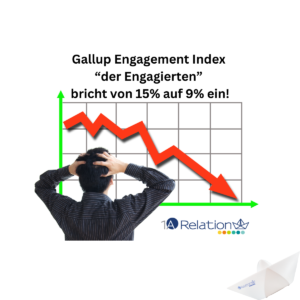Personalization – not a nice to-have, but a must-have!
Personal contact with the customer has always been important for a successful business transaction. In the early days of online retail, unlike the real shopping experience, it could not be served in the same way. There was a lack of opportunities in its current form to identify customers and their preferences and needs and to use this information. This is now possible with a personalized approach and personalized content.
One of many definitions of personalization
Personalization according to the understanding of the author is defined as follows:
Personalization is a specialized and data-driven form of customer contact in which the special needs of (potential) customers are taken into account. For this purpose, the customers are assigned to customer segments, which are compiled according to various criteria and data. These can also be built microsegment-based or 1:1-based. Numerous data sources, as far as possible automatically processed, form the basis. On this basis, the contents of a customer journey are designed in such a way that the customer goes through an individual customer experience with suitable information, offers and product recommendations. It is a process that should be continuously optimized and that leads to a relevant and individualized exchange between consumer/customer/consumer and company.
What makes the topic of personalization so important?
The topic of personalization has been one of the perennial favorite and trend topics in the field of customer loyalty for over 30 years. But why does this topic have such a significance?
Are you also one of those people who like it when you are greeted by name at your favorite Italian restaurant, placed at the table of your choice and the waitress knows what you want to drink? Psychologically, you feel like most people, you want to be noticed and receive recognition.
“Nothing stimulates us as much as the desire to be seen by others, the prospect of social recognition, the experience of positive affection and the experience of love. From a neurobiological point of view, the core of all motivation is therefore to find or give interpersonal recognition, appreciation and attention.”
Prof. Dr. Joachim Bauer, Quote from The Principle of Humanity, 2006, p. 34
According to Maslow’s pyramid of needs, personalization satisfies both social and individual needs. In particular, the desire for appreciation and respect can only be fulfilled by others ꟷ in this case by the personalizing company ꟷ. People basically need (social) contact, they want to make contacts, like to keep contacts or if the other person keeps in touch and a relationship develops from it.
Furthermore, the use of one’s own first and main name or well-known keywords ensure increased attention and focus or occupation with the advertising material.
In addition to these emotional components, personalization from the customer’s point of view also leads to an optimized customer experience, e.g. to an easier and faster findability of web content, which also saves time. All factors together increase customer satisfaction.
From the company’s point of view, the advantages are even more extensive:
A survey of Ascend2 marketing executives in December 2021 revealed the following distribution in terms of benefits:
Want to learn even more about the topic and get all 5 parts in one whitepaper?
Then sign in:
What are the biggest benefits of a successful personalization strategy?

The better you know your customers, the better you can segment your visitors and thus increase the long-term customer value of each individual visitor. In the e-commerce sector, personalization promotes impulse and repeat purchases.
For example, according to a study published in 2022 by Twilio Segment, nearly half of consumers say they are likely to become a repeat buyer after a personalized shopping experience at a retailer. According to the same study, one in three respondents (38%) said that they would buy again from a brand with which they had good experiences, even if there are cheaper or more convenient alternatives.
Compared to last year (45%), 62 percent of global respondents now say that a brand loses its loyalty when it delivers an unpersonalized customer experience. In terms of the American market, the values are even higher, according to a study published by McKinsey in 2021, more than three-quarters of respondents (76%) say that personalized content was a reason they considered a particular brand and 78 percent said that personalization is more likely to prompt them to buy again.
According to the McKinsey survey, personalization shows that in most cases, personalization leads to an increase in sales of 10 to 15 percent, with the range ranging from 5 to 25 percent increase depending on the industry and the degree of personalization). Thus, personalization can have a significant share in the profitability of a company.
Every beginning is difficult. How do I even get started?
First, you need a strategy. A strategy is like a compass that helps to do the right things at the right time. Therefore, the banal initial questions are: What do you want to achieve with personalization? For which target group? With what data?
Once this has been clarified, it is important to define goals and measures with which this can be implemented.
A personalization strategy can then look like this:
This results in a recurring cycle: Personalization results in a higher interaction rate as described above. This gives you new data and, on the basis of this information, you can sharpen the personas and customer journey and use it for the next measure.
Your personalization strategy should be reflected in all your marketing and sales channels and activities. Do not think in terms of individual measures and functionalities, but that you want to offer your customers a better customer experience throughout.

Choose a suitable technical solution
The basis of successful personalization is the interaction of the three core elements: data, content and delivery technology. But what makes the right personalization technology? The image of the egg-laying woolly milk sow hits it quite well: an integrated platform solution, as simple as possible, as complex as necessary and the whole thing expandable at the given time would be the optimum. However, a holistic solution is not possible or useful for every company.
However, the following things have to be considered:
- First the strategy, then the technology.
- An important basis is the address and data quality. Usually there are 15 to 20 variables that play a role at the start. For these selected variables, the degree of filling as well as the quality should be very high.
- Is a tool already available for planned personalization measures or can an existing tool also be adapted for this?
All other points can be found in the whitepaper:
A new form of organization is absolutely necessary
A company as a whole must get involved in the topic of personalization. In most cases, data silos have formed in companies. Teams and departments work with different information and systems. Existing data is fragmented, not available to all applications, and the lack of common standards makes it difficult to communicate and merge the data across applications.
However, a (potential) customer sees a company as a unit, even if internally different departments have customer contact over different phases of the customer journey. This requires either a single data source, good coordination of a process owner or optimally coordinated internal communication – preferably all together – so that customers can have a smooth and satisfying customer experience. Above all, however, there must be an acceptance of this form of customer approach in the company and the strategy and implementation must be supported by all parties involved.
Why it is worthwhile to plan an organizational realignment not only because of the silos, but also from many other cases, can be read here in the CRM manifesto by Georg Blum.
No experiments! – is the wrong philosophy! Quite the opposite!
Personalization also means making content new and relevant again and again. Adjust your error culture – if you haven’t already done so: Even if personalized actions don’t deliver the desired result, it’s not a failure. You will receive further data and valuable insights on the basis of which you can further optimize the personalized customer experience. Experiment on the content side, measure and analyze the information and data gained continuously and gradually increase your degree of personalization. In addition, create a process for integrating external insights.
And as mentioned earlier, start small and grow with your tasks.
In the next part, you will learn how personalization and individualization differ and why these two terms are often confused. What all this has to do with customer experience and what role A/B testing plays.
Note: This is a machine translation. It is neither 100% complete nor 100% correct. We can therefore not guarantee the result.















